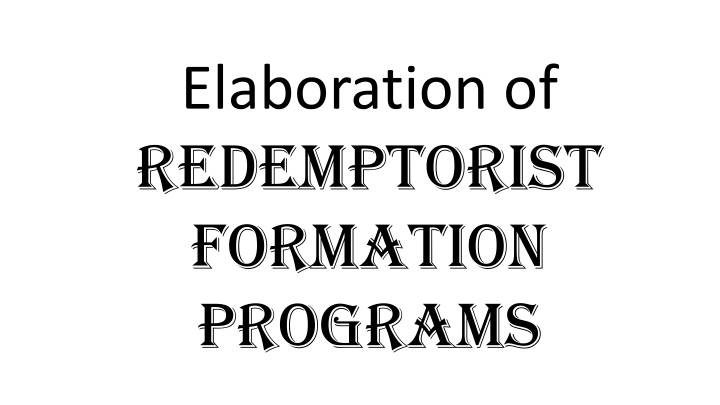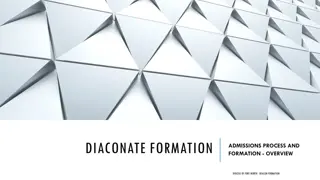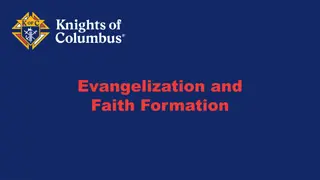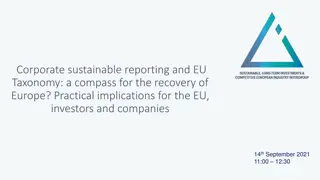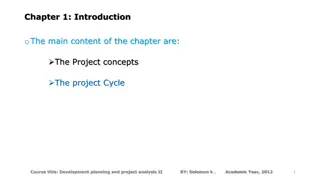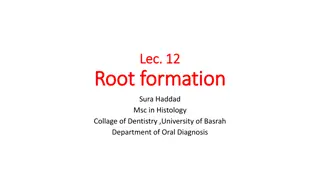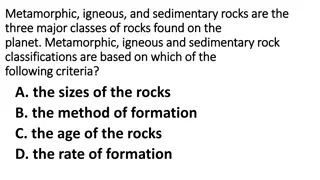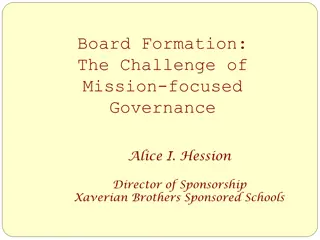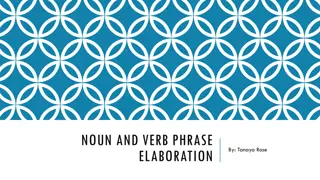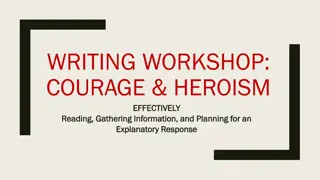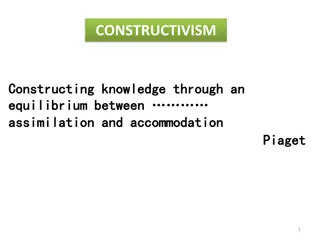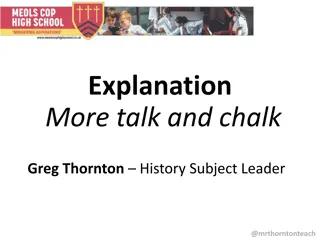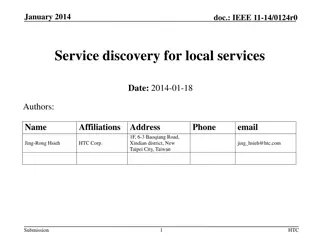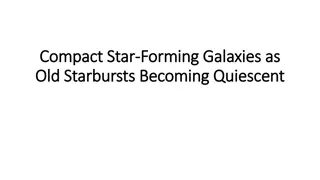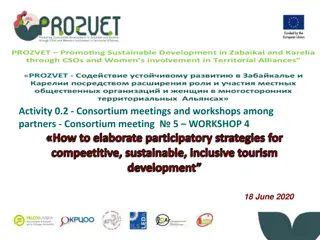Elaboration of Redemptorist Formation Programs
Reflecting on the role of a formator within the Redemptorist context, this content explores key aspects such as personal preparation, familiarity with formation documents, collaboration with fellow formators, continuing formation, and the balance of various duties. It delves into the skills, formation, and experience necessary for effectively transmitting Redemptorist spirituality and charism to those undergoing formation.
Download Presentation

Please find below an Image/Link to download the presentation.
The content on the website is provided AS IS for your information and personal use only. It may not be sold, licensed, or shared on other websites without obtaining consent from the author.If you encounter any issues during the download, it is possible that the publisher has removed the file from their server.
You are allowed to download the files provided on this website for personal or commercial use, subject to the condition that they are used lawfully. All files are the property of their respective owners.
The content on the website is provided AS IS for your information and personal use only. It may not be sold, licensed, or shared on other websites without obtaining consent from the author.
E N D
Presentation Transcript
Elaboration of Redemptorist Formation Programs
Initial reflection: Initial reflection: When you were asked to be a formator, When you were asked to be a formator, - Were you presented with the Were you presented with the expectations Superior or Conference Coordinator Superior or Conference Coordinator? ? - Were your personal expectations taken into account? Were your personal expectations taken into account? - Did you feel you had the necessary preparation and formation to be a Did you feel you had the necessary preparation and formation to be a formator? formator? - Did you have pastoral and missionary experience before being named a Did you have pastoral and missionary experience before being named a formator? formator? - Were you familiar with formation documents (Church and Redemptorist), for Were you familiar with formation documents (Church and Redemptorist), for example, example, Ratio Ratio Fundamentalis Fundamentalis Institutionis Institutionis Sacerdotalis Formationis Generalis Formationis Generalis - - 2020, Directories, Programs? 2020, Directories, Programs? expectations and and job description job description by your by your Sacerdotalis - - 2016, 2016, C.Ss.R. Ratio C.Ss.R. Ratio
- Were you given a program to follow, or was it just understood that you need to elaborate on your own the program for the stage you would be accompanying? - Was a collaboration network with other formators from your Unit or Conference set up in order to support each other and assure that the whole-global formation system would be progressive, systematic and integral? - Were you accompanied and supported (by your superiors and confreres)? - Have you participated in Continuing Formation of your Unit and/or Conference? - Do you feel over-burden with other time-consuming duties besides that of formation (teaching in Academic Institutes, member of Commissions and Secretariats, member of Unit/Conference leadership, participant in other Church or Civic related entities)?
What skills, formation and experience are needed to elaborate and transmit the content of formation for those who initiate the process and desire to identify and assimilate into their lives the Redemptorist Spirituality and Charism?
The following guidelines related to programs are applicable, although not explicitly indicated, to whether we are formators and accompaniers of Redemptorist Consecrated Life candidates and formandi or of our Lay Collaborators. Obviously, what is presented here is not the last word on this subject.
A word about some terminology: A word about some terminology: Ratio Formationis Generalis: The word ratio is a Latin word meaning reason,rationale . Ratio Formationis Generalisis a term in Latin that is used to signify the principles and values for formation in all of its stages. From these principles and values enunciated in the Ratio Formationis Generalis, the Directories, the Programs and other documents relating to formation are elaborated. Directories: The Directories present the organization and the structures of the Unit s or Conference s formation houses (and groups of laity). Directories are especially important as we enter more and more into the reconfiguration of Units and Conferences, and the structural adaptations we need for common initial and continuing formation.
In this presentation, we concentrate on PROGRAMS: Programs: The formation programs are the content of formation for each stage, that is, concretizations on how the different content elements of formation should transmited and fulfilled for each particular stage as reflected in the principles and values expressed in the Ratios.
Besides transmitting the content of formation, all the programs of the eight stages of formation need to be so designed as to assure that the global formation system is progressive, systematic and effective. Although the content of the various formation stages may be similar, the progressive nature of the content has to be sensitive to the recipients, that is, consonant with the capabilities and past exposure and experiences of the formandi, including the updating of material. We are not speaking here of the academic formation, which is given in non- Redemptorist Academic Institutes to which in general our formandi participate (which often needs to be complemented in our formation houses with our Redemptorist Academic needs, for example in Moral Theology). In speaking about Redemptorist Formation Programs, we are referring to the specific Redemptorist Spirituality and Charism content of our Religious, Missionary lives and mission.
Among the qualities of good programs used to transmit content to candidates and formandi of the different formation stages, are that these programs be: User friendly Practical Didactical
It is of utmost importance to establish that the formators are not the owners of formation, the programs, or the formation process. The owners are the Congregation, the Units and the Conference represented by their corresponding superiors. The formators are at the service of the Congregation, the Units and the Conference and subject to their supervision, accompaniment and evaluation.
The programs, as already mentioned, have to be progressive and elaborated in a systematic way at the service of a global vision of the whole formation process. For this to happen, especially the progression of the content, all the formators of a Unit or Conference have to work together as a team, under the supervision of the Superiors and Secretariats of Formation, in the elaboration of the programs of all eight stages of formation. A practical suggestion is that the formators of each stage prepare drafts of their corresponding program and in an assembly with all the other formators of the Unit or Conference, analyze and evaluate the content and methodology to be used in the transmission of the formation content. As the formators do this, they assure that the content is adapted to the formand in his particular stage, capacity, and assure that the deepening of the content is progressively assured in the following stages.
In other words, all the formators of the different stages of formation should be familiarized with the content and level of transmission of content of the formation stages prior and subsequent to their particular stage.
While generally familiar with the content of formation, many accompaniers (formators) feel they lack the skills, formation, creativity and teaching experience in transmitting and accompanying persons who are initiating their process and desire to identify and assimilate into their lives the Redemptorist Spirituality and Charism.
We need to recognize that most formators are not professionally trained teachers. For this reason, we need the help of professionals in the field and science of teaching. Perhaps, incorporated into the Secretariats and Formation teams, lay teacher professionals can be invited to participate to help us with this challenge. An example is the preparation of the content with a commonly used structure of a lesson-plan .
This lesson plan structure basically consists of five dimensions: They are: 1. What is the objective or aim of a particular formation session? 2. What is the content to be transmitted? 3. What is the methodology to be used? 4. How is the assimilation of the content to be evaluated? 5. What relative and adapted to the stage-bibliography is to be offered to the formandi? We now pass on to a brief explanation of each of these dimensions:
1. 1. Objective Objective: : - The The clearer clearer the avoidance avoidance of of tangents - The The Objective Objective should - The The clarity clarity of of the lesson lesson plan. plan. - Besides tailored to the participants according to their actual familiarity with Besides tailored to the participants according to their actual familiarity with the content and their particular stage of formation, it is important to avoid the content and their particular stage of formation, it is important to avoid the often the often- -made complaint by made complaint by formandi formandi that specific content has already been presented in previous stages and is being repeated. As a result, its been presented in previous stages and is being repeated. As a result, its understanding, meaning, and application are not deepened. understanding, meaning, and application are not deepened. the Objective Objective, , the tangents, , the should be the Objective Objective facilitates the more more coherent the concentration concentration of of the be able able to to be be simply facilitates all will be the formator formator and simply stated stated in all the the following following steps coherent will be the the lesson lesson, , the and the the formandi. formandi. one or or two two sentences sentences. . steps of of an an effective the in one effective that specific content has already
2. Content Some areas of content of formation are: (the content should be organized in a systematic way - although not linear - and in accordance with the five dimensions of formation) - - - - - - - - - - - - the values, teachings, and formation guidelines from Vatican II and other Church documents, the professed vows (for religious), the formation for community life, areas of affectivity and sexuality, the attitudes and processes involved in inculturation, the importance of Partners in Mission (PIM), the Congregation's Constitutions and Statutes, the history of the understanding and application of the Redemptorist Charism through the General Chapters, the elaboration of missionary projects in faithfulness to our particular Charism in the Church, the Apostolic priorities and plans of the Conferences, the different dimensions of formation (human, spiritual, community, academic, and pastoral missionary), complementary themes related to our Redemptorist life and mission not transmitted in the Academic pensum of the Institutes where our formandi study (for example on Moral Theology), etc., etc. -
3. METHODOLOGY: Since this dimensi n for the transmitting of our Redemptoristic life and misi n is fundamental for what we are proposing, we will consider it with more detail: - the creativity of the formator in the application of methodology is presumed and most welcomed - since the main objective of formators is the transmitting of our Redemptorist spirituality, the formators should be conscious of adopting a humble and reverent manner when speaking or acting within the group. The methodology has to be mindful of Christ's presence (Matthew 18:20). - All content is meant to be transmitted in an atmosphere of spiritual reflection and prayer. In part, this will be helped with a prayer at the beginning and end of the lessons. The prayers can be prepared by the formator, and even better, by assigned participants. Of course, the prayers are more effective when prepared from the context of the lesson being taught and in relationship with the Redemptorist history, Spirituality, Charism and application to the actual events and the lives of the participants.
The formators should help everyone feel as equal participants. Each person should feel that they are a beloved member of the group and are invited to participate in the session by taking turns to read, pray and animate the others. Recognizing that in Redemptorist circles we often use language and words that are specific and often ecclesiastical, and not commonly used, the use of language that everyone can understand is important so that no one feels left out. The formators should avoid giving a lengthy and verbose sharing that consumes other people's opportunities to offer their sharing.
The formators must avoid being authoritative or domineering by acting aggressively, flaunting knowledge or telling others what to do. If there is advice to be given, they do so after the reflection is done (Luke 9:23). If the group wanders away from the core and essence of the main theme of each session, they should be gently invited to re-focus. There is no need to prepare sharing in advance or to appoint people to share. The best approach is to wait patiently for God's Spirit to inspire generosity and remember to give thanks after someone volunteers to contribute their own faith experience.
Suggested and encouraged is the spending some time at the start of the next group session in order to share with one another on the influence and inspiration that the previous lesson has had on their lives. The different reflections challenge us to discern our call to follow and live the Redemptorist spirituality in such a way that this Spirituality is witnessed to by our lives and in our mission.
There are several ways of transmitting the elements of the contents besides the formal, lecture type presentation by the formator. For example, from a prior assignment of reading and reflection on an article or theme, the participants themselves can express their own reactions and reflections creating an atmosphere of faith-sharing, which also has the advantage of a type of evaluation by the formator of the assimilation into the lives of the participants.
Other observations as to the methodology: - helpful at the beginning of each session is a summary review of the previous class - breaking up the sessions with recesses - engaging all the senses - the use of symbols and visuals is always positive - opening a time-space for personal testimonies
- giving of an overall view of the formation course indicating the logical sequence that the contents will pursue with negotiation and concretizations of purpose, expectations, overall time-table, schedule, and even content, etc. - personal reflection and sharing on what and how diverse spiritualities have influenced our relationship with the Lord and our neighbor - previously prepared power points or videos, either by the formator or a participant, on the different Church spiritualities and Charisms, and indication how these influenced Saint Alphonsus - dramatization of a dialogue with the different personalities (Saints) of original inspiration - assuring of celebrative moments, for example, recognitions (birthdays, anniversaries, jubilees, feast days especially Redemptorist), etc.
- a particularly interesting part of the methodology of this lesson can be the testimony and projecting of images and photos of Alphonsian historical foundational places by a person who has visited the Alphonsian foundational houses in the South of Italy. These visits are programmed in the Spirituality course offered by the Redemptorist Spirituality Center in Rome every year in English and Spanish. The course, besides being for professed Redemptorists Religious, is also open to other members of the Redemptorist family.
4. EVALUATION: - in the following class, pointed questions asked of the participants, or even by the fellow participants, about the content of the former class, - opening a dialogue for clarifications, questions and comments (whether personal or relating to the content), - completion and results of an assignment given by the formators from the previous class - the active involvement of all the participants - the effective preparation of the formator by the participants
5. BIBLIOGRAPHY - the value of bibliographies is for further and deeper knowledge and insights into the material presented in clases - the bibliography can be used for the pointing out resources of the assignments given - there are different bibliographies available on different dimensions of Redemptorist Spirituality and geared for different stages of formation - a possibility is a floating or portable library of printed resources where participants sign out printed resources on specific topics. The participants can be motivated to contribute to the portable library with the sharing of materials they may already have and/or the donation of materials. - very important is the sharing of materials by the formators themselves and their experiences in the use of these materials
- A few of the webpages where content material is available are: www.cssr.news/formators this website contains material on Documents and Tools designed specifically for Redemptorist formation www.cssr.news this website is the official Redemptorist world website out of Rome and presents daily updates of events in the Redemptorist world www.santalfonsoedintorni.it this website in Italian has a wealth of information and documentation. It is updated almost daily. www.forworld.redemptory.pl/en/ from Poland but includes a wealth of formation material in English Many other websites from the Units and Conferences can be found with a simple google search.
LAST WORDS: There is so much more that can, should and will be said on this renewed way of considering and designing our formation programs. The times and needs of our Redemptorist life and misi n (Vita Apostolica) ask that we be in a constant process of renewal and re-imagining our charism as evangelizers of the proclamation of the Good News of Salvation to the Abandoned poor. Excelent, competent, and actualized formation with wise, integral, and mature formators is key to our being able and available to respond to our world which has entered into a new historical change of epoch.
